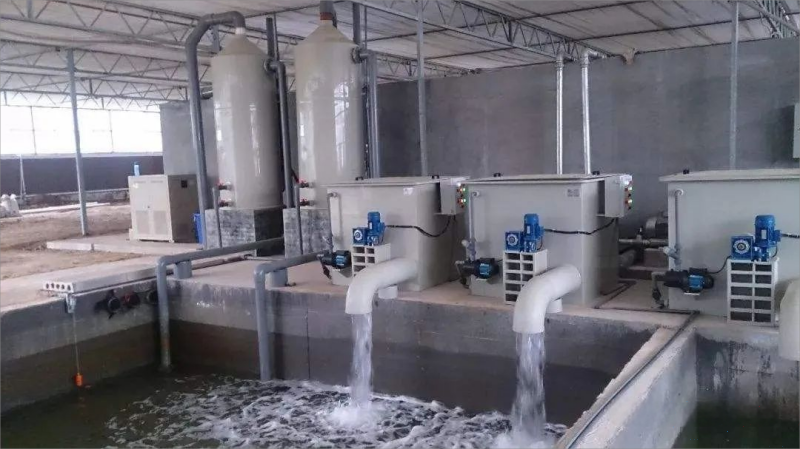Marketing Hotline:
(+86)0532-88988868
(+86)0532-88988868
In the process of operation of the industrial circulating cooling water system, the circulating water is continuously concentrated due to water evaporation and wind blowing loss, and the salts contained in it exceed the standard, the anion and cation increases, and the pH value changes significantly, resulting in the deterioration of water quality.
The temperature, pH and nutrient content of the circulating water are conducive to the growth of microorganisms, and the abundant sunlight on the cooling tower is an ideal place for algae growth. Scaling control, corrosion control, microbial control, etc., inevitably need to be treated with circulating water.
The main problems in the process of circulating water operation:
(1) Scale: Due to the continuous evaporation of circulating water during the cooling process, the salt concentration in the water continues to increase, exceeding the solubility of some salts and precipitating. Common scales include calcium carbonate, calcium phosphate, magnesium silicate and so on. The texture of the scale is relatively dense, which greatly reduces the heat transfer efficiency, and the scale thickness of 0.6 mm reduces the heat transfer coefficient by 20%.
(2) Dirt: Dirt is mainly composed of organic matter, microbial colonies and secretions, sediment, dust, etc. in the water, and the texture of the scale is soft, which not only reduces the heat transfer efficiency but also causes corrosion under the scale and shortens the service life of the equipment.
(3) Corrosion: The corrosion of circulating water on heat exchange equipment is mainly galvanic corrosion, which is caused by equipment manufacturing defects, sufficient oxygen in the water, corrosive ions in the water (Cl-, Fe2, Cu2) and the dirt generated by the mucus secreted by microorganisms, etc., and the consequences of corrosion are very serious, even if the heat exchanger and water pipeline equipment are scrapped in a very short time without control.
(4) Microbial slime: because there is sufficient oxygen, suitable temperature and nutrient conditions in the circulating water, it is very suitable for the growth and reproduction of microorganisms, if not controlled in time, it will quickly lead to water quality deterioration, odor and blackening, a large amount of slime deposition and even blockage of the cooling tower, the cooling and heat dissipation effect will be greatly reduced, and the corrosion of the equipment will be aggravated. Therefore, recirculating water treatment must control the growth of microorganisms.
Microbial hazards
The microorganisms in circulating cooling water come from two sources.
First, the cooling tower needs to introduce a large amount of air in the process of water evaporation, and microorganisms are also brought into the cooling water with the air;
Second, the make-up water of the cooling water system will have more or less microorganisms, and these microorganisms will also enter the cooling water system with the make-up water.
Algae will photosynthesize with carbon dioxide, bicarbonate and other carbon sources in the water under sunlight, absorb carbon as nutrients and release oxygen, so when algae multiply, it will increase the content of dissolved oxygen in the water, which is conducive to the depolarization of oxygen, and the corrosion process is accelerated.
The proliferation of microorganisms in the circulating water system will make the circulating water dark, produce foul odor, and pollute the environment. At the same time, a large amount of slime will be formed, which will reduce the cooling efficiency of the cooling tower, and the wood will deteriorate and rot. The slime deposited in the heat exchanger reduces the heat transfer efficiency and increases the head loss, and the slime deposited on the metal surface will cause serious underscale corrosion, and it also isolates the effect of corrosion and scale inhibitors on the metal, so that the agent can not play its due corrosion and scale inhibition effect. In addition to accelerating the corrosion under the scale, the biological secretions of some bacteria will also directly corrode the metal during the metabolic process. All these problems lead to the long-term safe operation of the circulating water system, affecting production and causing serious economic losses, therefore, the harm of microorganisms is as serious as the harm of scale and corrosion to the cooling water system, and it can even be said that the control of microbial harm is the primary priority compared to the three.
The movement of microorganisms in circulating water can be measured by the following chemical analysis items:
(1) Residual chlorine (free chlorine) When chlorinating and sterilizing, we should pay attention to the time and amount of residual chlorine, because when the microbial reproduction is serious, the chlorine consumption in the circulating water will be greatly increased.
(2) Ammonia circulating water generally does not contain ammonia, but due to the leakage of the process medium or the inhalation of ammonia in the air, it will also make the water contain ammonia, at this time can not be taken lightly, in addition to actively looking for the leakage point of ammonia, but also pay attention to whether the water contains nitrite, the ammonia content in the water is best controlled below 10mg/l.
(3) NO2- When ammonia and nitrite appear in the water, it is said that there are nitrite bacteria in the water to convert ammonia into nitrite, then it will be very difficult to chlorinate the circulating water system, the chlorine consumption will increase, the residual chlorine is difficult to reach the index, and the NO2- content in the water is best controlled at less than 1mg/l.
(4) Chemical oxygen demand When the reproduction of microorganisms in water is serious, COD will increase, because the mucus secreted by bacteria increases the content of organic matter in the water, so through the analysis of chemical oxygen demand, the movement of microbial changes in water can be observed, and the COD in water is best less than 5mg/l (KMnO4 method) under normal circumstances.
The harm caused by microorganisms in circulating water is very serious, and if you want to take measures after the harm caused by microorganisms, it is often half the effort and costs a lot of biocides and money. Therefore, it is necessary to thoroughly monitor the microbiological profile of the circulating cooling water in advance.
Concentrated water multiples
The concentration ratio of circulating water refers to the rate at which the circulating water is continuously concentrated due to water evaporation, wind loss and other conditions during the operation of the circulating water system (compared with supplementary water as a benchmark), which is an important comprehensive index to measure the quality of water quality control.
The concentration factor is low, the water consumption and sewage discharge are large, and the efficiency of the water treatment agent is not fully utilized; A high concentration factor can reduce the amount of water and save water treatment costs; However, if the concentration factor is too high, the scaling tendency of the water will increase, the difficulty of scaling control and corrosion control will increase, and the water treatment agent will fail, which is not conducive to the control of microorganisms, so the concentration factor of circulating water should have a reasonable control index.
Formation of limescale
In the circulating water system, scale is formed by supersaturated water-soluble components, and various salts are dissolved in the water, such as bicarbonate, carbonate, chloride, silicate, etc., among which dissolved bicarbonate such as Ca(HCO3)2 and Mg(HCO3)2 are the most unstable and easily decomposed to form carbonate.
Therefore, when there is more dissolved bicarbonate in the cooling water, the water flow through the surface of the heat exchanger, especially the surface with higher temperature, will be decomposed by heat; When phosphate and calcium ions are dissolved in water, calcium phosphate precipitation will also be produced; Calcium carbonate and Ca3(PO4)2 are difficult to solubility, and their solubility does not increase with the increase of temperature, but decreases with the increase of temperature.
Therefore, on the heat transfer surface of the heat exchanger, these insoluble salts are easy to reach a supersaturated state and crystallize in the water, especially when the water flow speed is small or the heat transfer surface is rough, these crystalline precipitates will be deposited on the heat transfer surface, forming the commonly known scale, because these scale crystals are dense and relatively hard, also known as hard scale, the common scale components are: calcium carbonate, calcium sulfate, calcium phosphate, magnesium salt, silicate.

Circulating water treatment technology
According to the characteristics and process conditions of the circulating water system of the enterprise, combined with the local water quality characteristics, select the water treatment scheme suitable for the operating conditions of the enterprise, and control the circulating water index to operate within a certain range through dosing and other measures, which not only ensures the long-term operation of the production equipment, but also improves the utilization rate of the circulating water.
The utilization of circulating water treatment technology can not only bring significant economic benefits to enterprises, but also bring good social benefits to the society. Therefore, the application of circulating water treatment technology is very necessary.


